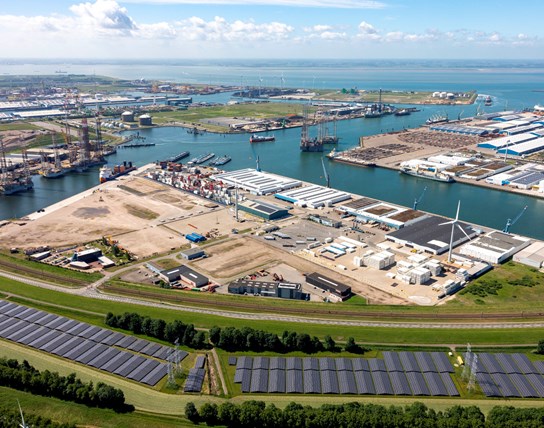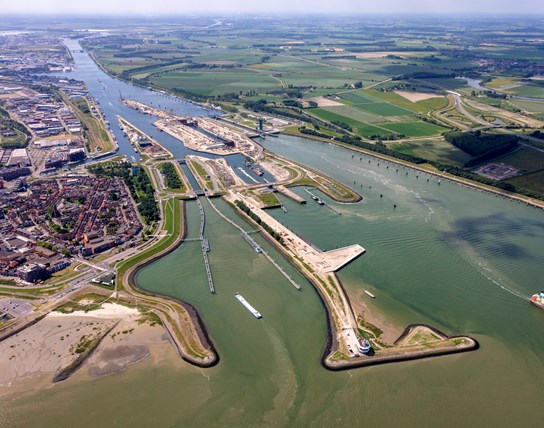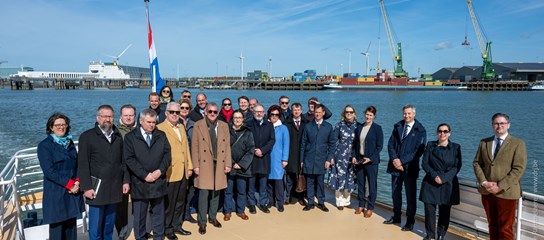North Sea Port: what has five years of merger brought us?
It was at the Flemish-Dutch Summit in Ghent on 7 November 2016 that the merger between Zeeland Seaports (Vlissingen and Terneuzen) and the port of Ghent was formally put on the agenda for the first time. One year, one month and one day later, on 8 December 2017, the new name was announced: North Sea Port, a name with some bravado, and with the baseline “Together Smarter”.
What has the regionally, (inter)nationally well-received merger produced in the meantime?
More jobs and investments
Five years later, the transhipment of goods by sea is experiencing its best year ever. With 73.6 million tonnes, 2022 was a record year for the third time. This is approximately 10% more than at the start. A start was made with 1,000 hectares of available land for investors. Now, 241ha of land has been issued in the port area; on average, it's three times more than expected per year. Employment has also risen: from 95,000 (in)direct jobs to 102,000, where only 100,000 were expected. This resulted in an added value of EUR 12.6 billion, while the forecast was EUR 12 billion.
More jobs and investments were realised in a world that looked different after the merger.
In a world transformed by Brexit, corona, war and energy prices, North Sea Port is holding up
Brexit presented an entire series of uncertainties, but it also provided opportunities. After all, the UK was and still is one of the main trading partners. The UK now holds third place. The corona pandemic was responsible for a blow for the transhipment of goods: a loss of 13% in 2020. Two years later this loss was recovered.
Then, the Russia/Ukraine war cut into trade relations in 2022. Russia is the second most important trading partner and trade suffered a loss of 15%. Russia has been overtaken by the USA. Trade with Ukraine has been halved. The war led to an energy crisis with an impact on activity and prices, resulting in inflation in the Netherlands and Belgium.
In these turbulent times, North Sea Port not only survived, but even made progress. The fifth year since the merger was the best year on record. Companies tried to play it safe in 2022 and looked for new supplies in other regions such as the US, Canada and Australia. But it was also a record year because the supply of raw materials continued to increase - the industry kept going.
The compass of the shareholders: climate, jobs and energy
Against the background of assumptions, forecasts and a changing world, shareholders provided the port with a compass. In the development, the port authority has three tasks: focus on economic development and employment, sustainability and climate and a financially sound basis.
Daan Schalck, CEO North Sea Port: “The development of the port is no longer just about tonnage. From now on, climate, jobs and energy will be guiding.”
The Strategic Plan “Connect 2025” saw the light of day in the autumn of 2021. In order to develop the port as a top European port, the coming years will see investments in circular economy, climate, energy, logistics chain, infrastructure and digitisation. The relationship with companies, governments and environment will receive special attention, with the port authority acting as a connector.
Results across borders
At the start, the merger had the ambition to achieve results across the border. After five years, companies, the port authority and the political world can boast many results. Without the merger, these might not (yet) have been achieved or would have been achieved more slowly.
- Rail Ghent Terneuzen: improvement and realisation of cross-border rail The Netherlands has already released 105 million euros for this. North Sea Port also looks forward to the Belgian contribution. After all, rail transport is increasing.
- Hydrogen: realisation of one pipeline network by 2026/2027. Companies that need hydrogen can link to this. Many investments for hydrogen plants are planned. As the largest hydrogen hub in the Benelux, North Sea Port can further develop into a European hub.
- CO2: towards a climate-neutral port The ambition is to emit 50% less CO2 by 2030, and to achieve a net-zero port by 2050. Many investments are planned, as are modifications to terminals for the reduction, capture, storage, use and transport of CO2.
- Safety: on various fronts North Sea Port, Zeeland Security Region and Fire Service Zone Centre are joining forces for cross-border incident response. Collaboration and knowledge exchange not only led to extra attention to disruptive crime in Zeeland but also in Ghent.
- Cooperation between European ports North Sea Port and the Port of Göteborg are setting up a network of medium-sized European ports and are working on energy management. Both ports also want to realise a Green corridor to reduce emissions on this transport corridor.
- Smoother and more efficient shipping The nautical cooperation in the port area was one of the reasons that led to the merger. The merger resulted in more thorough planning and better agreements between chain partners, more efficient safety monitoring and further digitisation.
- Smart Delta Resources: companies join forces Zeeland already held SDR, where energy and raw material-intensive companies from the chemical, steel, energy and food sector work together with the port and authorities to effect the energy transition. The merger has ensured that SDR is also well established in Flanders.
- Shareholders continue to work together The eight shareholders are all represented in the Supervisory Board. The merger brought about even more cooperation in the region. North Sea Port District was set up to work on Accessibility & connections, Attractive living landscape, Housing, labour market & training and Energy & Circularity. They are also setting up a Benelux Group for Territorial Cooperation to make it easier to set up joint projects, obtain subsidies and solve border obstacles.
- On the radar in the region, The Hague, Brussels and Europe Because of the merger, the regions invest more effectively in infrastructure and more budget is released for new initiatives, such as rail development, hydrogen, CO2, safety and shipping assistance. The recognition of North Sea Port District as a so-called Novi area (National Environmental Vision) shows this. Here, the focus is on housing, labour market and training. The recognition as European cross-border experimental region maps out a host of obstacles to set up activities in the port area. The ever-increasing brand awareness is also reflected in visits by ambassadors, secretaries of state, ministers, European Commissioners in the port area and with companies. This will increase the likelihood that North Sea Port is placed on governmental shortlists for financial support or infrastructure investments.
Ready for the future
North Sea Port's baseline is “Together Smarter”. After five years, people in politics, companies, infrastructure operators, organisations and the population are on the same page.
At the start, North Sea Port joined the top of European ports. After five years, it has become a player of national and European importance. North Sea Port is ready to continue to tackle the challenges for the coming years.






